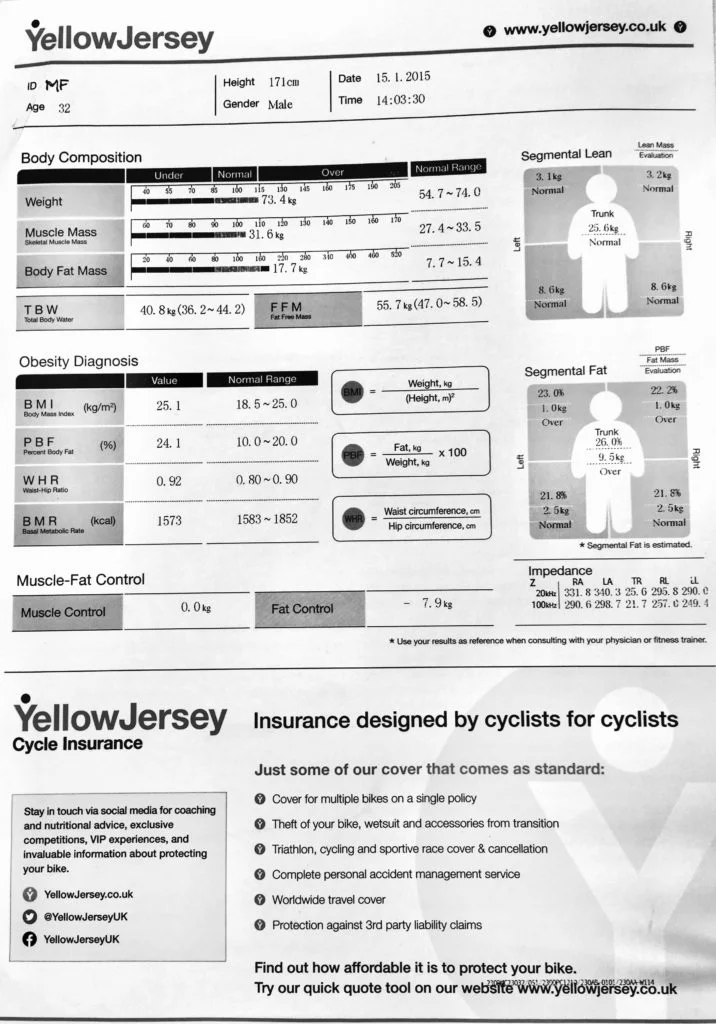
Throughout the summer the Yellow Jersey team have been attending cycling and triathlon events across the country conducting segmental lean analysis with our InBody Machine. It’s been hugely popular with people lining up for 20 mins, desperate to find out ‘what they’re really made of.’
If you’re lucky enough to have been armed with this information, what does segmental lean analysis actually mean? How can this knowledge help your cycling and triathlon?

Regularly monitoring body fat and muscle development can help you understand how your diet, lifestyle, and exercise regimens influence your body composition. Knowing how your body works can help you target and reach your long term fitness goals faster and more efficiently.
We’ve outlined a number of the terms used on the InBody composition read-out here:
- Normal Ranges– this column is next to the one that displays your personal readings. The normal ranges have been established by analysing national averages and determining what is optimal from a health perspective. Although being super lean might be great for your race times, it might not be ideal when it comes to supporting your body to complete its core functions.
- Weight– is of course dependent on body shape and size. Not everyone’s physiology lends itself to climbing mountains and likewise not everyone can be a power house on the flats. But most cyclists know that when they’re going uphill, their power to weight ratio is key. So spending thousands of pounds on super light bikes is all well and good (and if you need insurance did I mention I know a really good company?) but the few ounces saved on that beautiful carbon frame will be pretty much redundant if you’re carrying a spare tyre – or two – round your midriff.
- Skeletal Muscle Mass– this is the total amount of muscle contained in your body. It sounds obvious but the higher your muscle mass, the lower your body fat percentage will be.
- Body Fat Mass– this is the total amount of fat contained in your body. A number of people we’ve measured are within the normal range for Body Fat Mass but due to a Skeletal Muscle Mass their Percentage Body Fat is outside of the normal range for Body Fat Percentage.
- Percentage Body Fat– this is a headline figure that we tend to find most people are anxious to learn about. This figure reveals just how lean you are. Body Fat Percentage is also a more important consideration for health professionals in the diagnosis of obesity than weight alone. Bradley Wiggins is said to have had a body fat percentage as low as 4% when competing in the tour.
- Total Body Water Percentage– our bodies need water for a number of reasons. Water helps in the movement of nutrients through the body and in the expelling of waste products from the body. It enables organs to function, regulates body temperature, assists digestion and aids muscle performance. Optimum hydration levels improve concentration, performance and all-round wellbeing.
- Basal Metabolic Rate– is the amount of energy your body would use if it were at complete rest for 24 hours. It is the minimum amount of energy required to sustain your vital organs and body functions excluding digestion. We all know it’s a simple formula to lose weight. Eat fewer calories than you use, and you will burn your stored reserves of calories. Ideally, those reserves will be made up of body fat. What you don’t want to do is lose muscle as that could compromise your performance. So, any weight loss should be done in a controlled fashion to prevent muscle wastage. Having an exact BMR figure is very useful as you can then calculate and add to it the exact number of calories you burn during your daily activity. Each day a small deficit off this total can be targeted until you hit your target body fat percentage.
- Muscle & Fat Control– the “Muscle and Fat Control” figures present the amount of weight required to move you back into the middle of the normal ranges. Although the normal ranges are based on the general population and might not be ideally suited to achieving optimum performance in your preferred sport.
- Segmental Lean & Fat– the Inbody also provides a breakdown of the muscle and fat content of each limb as well as your core area (it’s referred to on the sheet as “Trunk” as the machine was probably developed in America.) This breakdown is very helpful in identifying where your excess weight or weakness might be. For example, most cyclists don’t want to be carrying unnecessary amounts of muscle on their upper bodies so could reduce their weights regime if this is the case. Conversely if the test revealed you’re under developed centrally, you may want to prioritise a core work out each week instead of squeezing in another ride.
How does the InBody machine work?
One question that cropped up a lot was how does the device work? Well, it sends tiny electrical impulses through the body and times how quickly those impulses take to return. Lean muscle tissue conducts electricity faster than fat, so a quicker response time correlates with a leaner physique.
Unlike simple bathroom scales, the InBody Machine takes measurements via eight locations on the body to ensure precision. It also uses multiple frequencies and generates results with a far higher degree of accuracy because single, low frequency electrical currents have difficulty penetrating cell membranes and assessing intracellular water.
For consistent results, test conditions should be kept the same from test to test i.e. if you measured yourself after eating breakfast and pre-exercise you should replicate these conditions if you have a follow up test in order to be able to accurately compare results.
We hope the above information has been of use and if you’d like to know more please get in touch.
Remember if you have a health concern of any kind, consult with your health care professional. You should also consult with a healthcare professional before starting any diet, exercise, supplementation or medication program. Statements by Yellow Jersey are not intended to diagnose, treat, cure, or prevent disease. Information presented by Yellow Jersey is for educational purposes only and is not meant to be a substitute for the advice of a doctor or other medical professional.
Yellow Jersey will be providing FREE InBody Composition Analysis tests (worth up to £40) at events around the UK during the summer.
